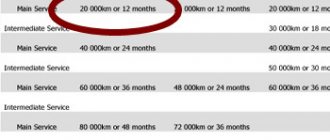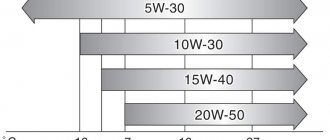The first original oil for Toyota automatic transmissions appeared in the 80s for A241 and A540 gearboxes. With the development of electronic control, the fluid composition was modernized several times. Which ATF is suitable for a particular box must be clarified in the operating manual. Recommendations may change not only for the automatic transmission model, but also depending on the year of manufacture.
Toyota automatic transmission oil
| Toyota Alphard | Toyota Auris | Toyota Avensis | Toyota Camry |
| Toyota Camry v30 | Toyota Camry v40 | Toyota Camry v50 | Toyota Camry v55 |
| Toyota Camry v70 | Toyota Carina | Toyota Chaser | Toyota Corolla |
| Toyota Corolla 120 | Toyota Corolla 150 | Toyota Crown | Toyota Fortuner |
| Toyota Harrier | Toyota Highlander | Toyota Hilux | Toyota Ipsum |
| Toyota Land Cruiser 100 | Toyota Land Cruiser 200 | Toyota Mark 2/X | Toyota Prado |
| Toyota Prado 120 | Toyota Prado 150 | Toyota Prius | Toyota Rav4 |
| Toyota Rav4 2 | Toyota Rav4 3 | Toyota Rav4 4 | Toyota Venza |
| Toyota Vitz |
Is it possible to use analogues?
YES, of course you can, as you can see from the list, I have already indicated that some manufacturers indicate oils from third-party manufacturers, not their own brand. Everything here is natural, because often brands do not produce lubricants themselves, but simply pour them into their own packaging and sell them at a higher price.
Therefore, you need to find out your tolerances and find the same ones only non-original ones, it will also be cheaper. For example, for my AVEO, original GM oil costs about 700 rubles a liter, but if you take Mobil, for example, the price drops to 550 - 600 rubles.
However, it is worth remembering about the quality of the lubricant; the dealer has a high chance that you will buy the original, but there are a lot of fakes in stores.
Selection of oil for Toyota automatic transmission
On this page you can select automatic transmission oil (automatic transmission) for Toyota cars according to the car model. Simply select from the list above by clicking on the image.
Toyota Motor Corporation is the largest Japanese automobile manufacturer, which also occupies a leading position in the global automotive industry. This automaker gave the world such recognizable models of passenger vehicles as Toyota Camry, Toyota Corolla, Toyota Avensis, Toyota Venza, Rav4 SUVs, Land Cruiser, Highlander, Prado and many others. At the same time, it is also worth noting the solid arsenal of automatic transmissions that were equipped with various model lines of this eminent automaker, developed by no less eminent corporations. Accordingly, in this article we will talk about transmission oil in Toyota automatic transmissions, consider its factory tolerances, and also touch on the topic of checking the oil level and the procedure for replacing it in Toyota automatic transmissions.
Why is it important to take only your own tolerances and characteristics?
What I mean is that, for example, with motor oils you can “play around” with tolerances a little, although it is not advisable! Instead of 5W-30, in some cases you can fill in 5W-40, or vice versa.
With an automatic transmission this is categorically excluded! Why? YES, everything is simple, it’s worth remembering how it works , here the main torque is transmitted through a liquid, namely a torque converter. If you fill in a liquid that is even slightly different from the desired characteristics, this can lead to disastrous results. At a minimum, the box will “kick”, at a maximum it may not work at all. So don’t experiment, take “what the doctor ordered.”
Toyota automatic transmission oil
About approvals
Toyota vehicles, depending on the model range and year of manufacture of the vehicle, were equipped with 4, 5, 6 and 8-speed automatic transmissions, as well as continuously variable transmissions. Accordingly, the transmission fluid that is required for their maintenance has individual tolerances. The main specifications are Toyota T4, Toyota WS, Toyota CVT Fluid TC and CVT FE Toyota. At the same time, it is very important to adhere to these tolerances when choosing oil for a Toyota automatic transmission.
Toyota Corolla XI
Produced from May 2012 to July 2021 in E160, 170 and 180 bodies. Sedan - Corolla Axio, station wagon - Corolla Fielder. Read here about the restyled Toyota Corolla E170 sedan.
The car was equipped with transmissions: manual transmission and V-belt continuously variable variator MultiDrive S. Automatic transmission was not provided.
Let's look at what kind of oil needs to be poured into a Toyota Corolla box using the example of a model in the E180 body.
Manual Transmission
For manual transmissions of the eleventh generation Toyota Corolla, you must adhere to the specifications - API GL4 and SAE 75W. Filled volume – 2.4 l. In a new car, the manual transmission may immediately be filled with Toyota Genuine Manual Transmission Gear Oil Lv, you need to look at the documentation.
The best option is considered to be LV GL4 75W MT - article number 0888581001 or a complete analogue of the first Ravenol MTF 3 75w.
What kind of oil to fill in a Toyota automatic transmission before 2005
With the introduction of automatic transmissions on models of the Japanese manufacturer Toyota, the first original transmission fluid specification appeared, helping to select the highest quality oil for a Toyota automatic. Accordingly, until 2005, almost all automatic transmissions of this automaker were filled with transmission fluid with Toyota T4 approval. In fact, this is the original high-viscosity mineral oil of the same name, which is available in iron and plastic containers of 1 and 4 liters, and also has a whole series of substitutes.
How to distinguish a fake from the original?
What is the difference between original transmission oil and a fake one, and how to understand whether the product you are looking at is natural or not - branded products cannot be cheap, in addition, there are special differences, trademark protection:
- Availability of ideal branded packaging;
- The presence of a branded cover without signs of opening;
- Batch code – which should be clearly visible and readable;
- The logo is clear with no blurring of colors or squares (pixels);
- Measuring scale on the plastic canister on the side;
- Availability of a QR code and indication of the factory that produced the product;
- No two canisters can have the same production date;
- The production date of the container cannot be later than the date of production of the oils;
- The branded canister does not leak, even when turned upside down;
Additional insurance against counterfeiting will be the purchase of products in branded retail outlets and not on tap.
What type of oil is used in a Toyota automatic transmission after 2005?
After 2005, Toyota relied on more dynamic automatic transmissions, installing them in various vehicles of different model series. Accordingly, with an increase in the operating temperature of the transmission fluid, improvement of the oil itself was required. Accordingly, the old specification was replaced with a more current Toyota WS approval, which is possessed by the original Toyota gear oil of the same name, as well as its analogues. It is also worth noting that the automaker considers this synthetic oil non-replaceable. But, as practice shows, this is far from the case.
History of appearance and operating principle of automatic transmission
Automatic transmission is one of the main components of the transmission of a modern car. The main task of this unit is to create balance between the running engine and the spinning wheels. This work is carried out by finely selecting the gear ratio for each mode of engine operation. The main difference between an automatic transmission and a manual transmission is its fully automatic operation, which does not require driver intervention.
The first prototype of an automatic transmission appeared at the Henry Ford plant in the 20s of the last century. It was different from modern units, but the rudiments of modern machines were already present in them. More advanced units began to be produced after one decade -. They were operated on the principle of a servo drive, which is a mechanical gearbox with automatic state correction through negative feedback.
At the end of the 30s, the Chrysler organization introduced an innovative development that included a fluid coupling and a torque converter. This machine was a breakthrough in the automotive industry.
A more or less similar automatic transmission was developed in the early 50s by American engineers. It consisted of 3 parts:
- electronic;
- hydraulic;
- mechanical.
The development began to be actively used only in the 80s, during the period of rapid progress in microprocessor technologies.
The operating principle of the machine comes down to automating gear shifting. Before we consider in detail the structure and operating features of automatic transmissions, it is worth highlighting their varieties:
- variable speed drive;
- robotic gearbox;
- An automatic transmission equipped with a torque converter is considered a standard automatic transmission.
The design works thanks to the close interaction of electronics, mechanical parts and hydraulics. These elements are represented by the following details:
A torque converter that receives torque from the engine and transmits it to the shaft.
- A gearbox that receives force from a torque converter and drives the wheels through a gearbox.
- Control devices that regulate the head control of the unit and are responsible for the mechanics of the box.
The role of the driver in an automatic transmission is assigned to the control devices. Since an automatic transmission is more complex than a manual transmission, the oil for it is selected more carefully.
What kind of oil to pour into a Toyota automatic transmission if a variator is installed
Continuously variable transmissions, which are also actively installed on Toyota brand cars, are considered more demanding of the transmission oil poured into them. Therefore, the oil used in them is radically different from the transmission fluid poured into hydromechanical automatic transmissions. Until 2012, all CVTs were filled with original Toyota CVT Fluid TC oil, and after 2012 - Toyota CVT FE transmission fluid. All these oils are intended for use exclusively in CVTs.
atf ws oil
This branded liquid for automatic transmissions meets international quality standards. It is capable of working in any conditions and freezes at -44, which allows its use even in the northern regions of Russia. Withstands any driving conditions, from highways with frequent speed changes to city traffic jams.
Significantly prolongs the operation of all parts and reduces fuel consumption by minimizing friction. Used exclusively in branded Toyota models, suitable for Lexus car boxes.
In terms of service life, it is equivalent to “eternal”, that is, it is quite enough for the entire life of the machine. Has no disadvantages.
Frequency of oil change in Toyota automatic transmission
Toyota automatic transmission oil should be changed only when the transmission fluid loses its beneficial properties. And you should not trust the words of official dealers who claim that Toyota transmission oil is filled in the automatic transmission for the entire service life of the automatic transmission, or until the first major overhaul of the automatic transmission. Indeed, taking into account the difficult operating conditions of the automatic transmission, its technical malfunctions and low-quality oil, which many car owners of these Japanese cars pour into the automatic transmission in order to save money, the oil change interval is usually 40-60 thousand kilometers. The best option is to regularly check the oil level in a Toyota automatic transmission, which also allows you to assess the technical condition of the transmission fluid in the automatic transmission of your car.
Atf type t4 oil
This synthetic fluid is used only in AISIN automatic transmissions that have a standby system. Can be used for Toyota Avensis and other passenger vehicles, SUVs and small trucks.
To avoid loss of properties and premature failure of the fluid, the manufacturer recommends:
- Use liquids only within the time limits indicated on the container (packaging);
- Store the liquid in a dry place, away from sunlight;
- Barrels containing ATP should be stored outdoors under canopies in the “sideways” position;
How to check the oil in a Toyota automatic transmission
Checking the oil in a Toyota automatic transmission can be done either using a dipstick or through a control plug. Everything again depends on the modification of your car’s automatic transmission. So, the correct check of oil in a Toyota automatic transmission using a dipstick is performed as follows:
- the oil in the machine warms up to 70 degrees
- the car is placed on a level surface
- move the automatic transmission selector to position N
- clean the dipstick from oil
- take measurements and analyze the location of the oil between the control marks of the dipstick
Checking the oil level in a Toyota automatic transmission using a dipstick
It should be understood that not all car owners of these Japanese cars know how to check the oil level in a Toyota automatic transmission if there is simply no dipstick. Accordingly, the oil level in a Toyota automatic transmission in this case is checked through the control plug:
- The transmission fluid is heated to 70 degrees
- The car is placed on a horizontal area without distortion
- move the machine selector to neutral
- unscrew the lower control plug of the machine
- analyze the oil level in the automatic transmission based on the intensity of its leakage from under a given plug
Checking the oil level in a Toyota automatic transmission without a dipstick
The car's operating instructions are the best assistant in choosing the right oil.
The most convenient way to determine the brand of oil is to look at the vehicle's service instructions. If it gets lost, the information is easy to find. All you have to do is find the liquid in the instructions and purchase it.
For example, owners of AvtoVAZ cars are recommended to use the following lubricants:
- "Omskoil Trans P", with indexes GL-4/5 b 80W-85.
- "Rexol T" with indices GL-4 and 80W.
- "Volnez TM4" - indexes 80W-90 and GL-4.
For foreign models of the VAZ group, any oil corresponding to GL-3 is suitable. However, when purchasing transmission fluid from unverified suppliers, you may come across a fake that does not meet the required qualities.
Changing the oil in a Toyota automatic transmission
When the brand of oil for the automatic transmission of your Toyota car has been selected, and there is no doubt about the need to replace the transmission fluid, it is worth talking about this technical operation. So, an oil change in a Toyota automatic transmission can be complete or partial. A complete replacement of transmission fluid by displacement is performed using a special vacuum unit and requires the purchase of a larger volume of oil. But a partial oil change in a Toyota automatic transmission is considered simpler, and is much cheaper in terms of money. So, a partial oil change in a Toyota automatic transmission consists of the following manipulations:
- placing the car on an inspection pit or overpass
- removing engine protection
- unscrewing the drain plug from the bottom of the automatic transmission
- dismantling the machine tray (if any)
- waste drain
- replacing the oil filter and consumables (if necessary)
- filling the purchased transmission fluid, after which the oil level in the Toyota automatic transmission must be set
Partial oil change in Toyota automatic transmission
Lubricant composition
The presence of such a range of functions determines which components should be included in the lubricant mixture. In addition to the base product (synthetic, semi-synthetic, mineral), the oil contains a package of additives that improve its properties:
- Antioxidants. High temperatures and oxygen lead to premature aging of the oil, which results in the formation of varnish deposits, resinous substances and sludge. Antioxidants neutralize them throughout the life of the oil, slowing down the aging process.
- Anti-corrosion additives. They form a protective layer on the surface of parts, preventing chemical corrosion of metals.
- Viscosity index modifiers. They improve the viscosity-temperature characteristics of the lubricant by changing the volume of high-molecular polymers of which they are composed.
- Additives that improve lubricating properties. These additives form a super-strong protective layer on friction surfaces, providing better wear protection.
- Detergent additives, dispersants. Keep wear products in suspension, preventing them from settling.
- Anti-foam additives. Designed to prevent foam formation and promote its rapid destruction by reducing the surface tension of the lubricant.
Important: Different brands of ATF have similar properties. They differ only in operational characteristics and friction indicator. It is these properties that affect the applicability of ATF in automatic transmissions of various models.











